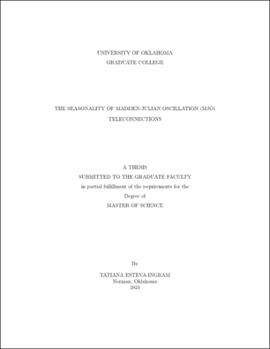| dc.contributor.advisor | Sakaeda, Naoko | |
| dc.contributor.author | Esteva-Ingram, Tatiana | |
| dc.date.accessioned | 2023-07-12T16:54:04Z | |
| dc.date.available | 2023-07-12T16:54:04Z | |
| dc.date.issued | 2023-08-04 | |
| dc.identifier.uri | https://hdl.handle.net/11244/337928 | |
| dc.description.abstract | The Madden Julian Oscillation (MJO) is a tropical intraseasonal phenomenon that is known to generate teleconnections like the Pacific North American and the North Atlantic Oscillation patterns in boreal winter, but knowledge about MJO teleconnections is limited during other seasons. Therefore, to advance the prediction skill of the extratropics on the subseasonal-to-seasonal (S2S) using the MJO as a predictor, it is important to better understand the seasonal relationship between the MJO and its teleconnections. To improve the S2S predictions during all seasons, this research demonstrates the strong seasonal variability of MJO teleconnections and investigates the causes of this seasonality using reanalysis and satellite data. We find that the MJO is tied to different leading modes of extratropical circulation that vary seasonally. While the MJO is strongly tied to some leading modes of the extratropics in winter, the MJO has weak relationships to the extratropical leading modes in other seasons, limiting the usability of the MJO as an S2S prediction tool. This seasonal variability in the strength and location of MJO teleconnection was found to be strongly related to the Rossby Wave Source (RWS) generated by the MJO. The generation of the RWS is determined by the seasonal location of the subtropical jet along with the strength and phase of the MJO. While the seasonal background state is often thought to play an important role, this work finds that the seasonal state of the MJO has a greater impact on determining the observed seasonal RWS patterns. This study offers an understanding that our current knowledge of MJO teleconnections during boreal winter would have limitations if applied to the other seasons and should be modified. Our current research indicates that the usability of the MJO as an S2S prediction tool in other seasons may depend on finding "windows of opportunities" that strengthen the ability of the MJO to form teleconnection patterns, such as other sources of interannual variability. | en_US |
| dc.language | en_US | en_US |
| dc.rights | Attribution-NonCommercial-NoDerivatives 4.0 International | * |
| dc.rights.uri | https://creativecommons.org/licenses/by-nc-nd/4.0/ | * |
| dc.subject | Meteorology | en_US |
| dc.subject | MJO | en_US |
| dc.subject | Teleconnections | en_US |
| dc.subject | Seasonality | en_US |
| dc.title | The Seasonality of Madden-Julian Oscillation (MJO) Teleconnections | en_US |
| dc.contributor.committeeMember | Pegion, Kathleen | |
| dc.contributor.committeeMember | Furtado, Jason | |
| dc.date.manuscript | 2023-07 | |
| dc.thesis.degree | Master of Science | en_US |
| ou.group | College of Atmospheric and Geographic Sciences::School of Meteorology | en_US |
| shareok.nativefileaccess | restricted | en_US |

